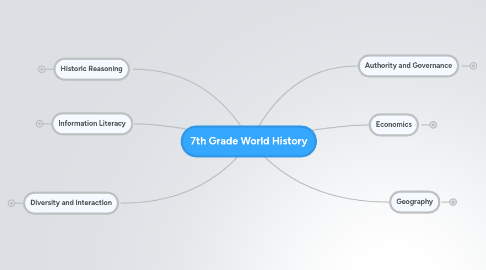
1. Historic Reasoning
1.1. Draw conclusions or make predictions based on data
1.1.1. Draw conclusions based on evidence
1.1.2. Make predictions based on patterns and available evidence
1.1.3. Identify trends and patterns in data
1.1.4. Analyze and interpret historic data from tables, charts and graphs
1.2. Present an argument based on relevant reasoning
1.2.1. Develop and present a reasonable claim or thesis
1.2.2. Provide relevant evidence to support claims
1.3. Identify and describe cause/effect relationships
1.3.1. Read and interpret timelines to determine chronology
1.3.2. Trace relevant cause(s) of an event
1.3.3. Trace relevant effect(s) of an event
1.3.4. Make predictions based on cause/effect patterns
2. Information Literacy
2.1. Locate information effectively from a variety of sources
2.1.1. Determine needed information (research questions)
2.1.2. Apply search strategies to locate needed information
2.2. Evaluate information quality
2.2.1. Determine bias
2.2.2. Distinguish between fact/opinion
2.2.3. Distinguish between primary and secondary sources
2.2.4. Evaluate source quality for accuracy and credibility
2.3. Gather and organize information ethically and legally
2.3.1. Use note-taking strategies to collect information
2.3.2. Organize information using a variety of methods (graphic organizers, outlines, etc)
2.3.3. Give credit to sources
2.4. Process and synthesize information to make meaning
2.4.1. Comprehend and evaluate written, visual and oral presentations and works
2.4.2. Collaborate with others to share information and make meaning
2.4.3. Synthesize information from a variety of sources
2.4.4. Apply information to new contexts
2.5. Communicate information clearly
2.5.1. Plan presentations considering audience and purpose
2.5.2. Utilize a variety of presentation formats enhanced with media
3. Diversity and Interaction
3.1. Recognize and respect diversity among peoples
3.1.1. Describe factors that influence people’s culture (religion, history, etc)
3.1.2. Examine impact of cultural influences on people’s behavior and perception
3.1.3. Recognize cultural biases and their impact on cultural interactions
3.2. Interact constructively with others
3.2.1. Demonstrate respect for others
3.2.2. Make positive contributions to team efforts
3.2.3. Share ideas and differences appropriately
3.2.4. Analyze examples of interactions between regions of the world over time
3.3. Identify causes and solutions to conflict
3.3.1. Recognize sources of conflict among individuals and cultures
3.3.2. Propose solutions to conflict among individuals and cultures
3.3.3. Analyze effectiveness of proposed solutions
4. Geography
4.1. Determine geographic influence on historic events
4.1.1. Explain how people adapt to their environment
4.1.2. Describe how people change their environment to meet their needs
4.1.3. Explain how geographic factors influence people’s lives (movement, culture, resource distribution, isolation)
4.2. Process and report geographic information
4.2.1. Read and interpret maps using map features (scale, legend, compass)
4.2.2. Use absolute and relative location to describe locations of real places both past and present
4.2.3. Read and interpret a variety of maps (physical, political, historical, demographic, etc)
4.2.4. Construct maps to process and report geographic information
5. Economics
5.1. Describe how people’s needs are met within a civilization
5.1.1. Explain the role of specialization and interdependence in forming and maintaining a community.
5.1.2. Identify and explain economic factors: surplus, scarcity, sources of wealth, opportunity costs
5.1.3. Describe trade relationships and their impacts (meeting needs, cultural exchange)
5.2. Determine impacts of economic factors on historic events
5.2.1. Analyze economic factors in decisions
5.2.2. Explain relationship between events and economic factors
6. Authority and Governance
6.1. Identify types and sources of authority
6.1.1. Identify rule of law
6.1.2. Distinguish between limited and unlimited governments
6.1.3. Describe qualities of effective leadership
6.2. Describe how governments influence people’s lives
6.2.1. Compare and contrast governments and authorities
6.2.2. Describe how people’s lives vary under different governments
6.3. Describe principles and structures of democracy
6.3.1. Describe origins of democratic government
6.3.2. Identify democratic principles (majority rule, minority rights)
6.3.3. Explain democratic structures (checks and balances, representation)
6.3.4. Explain how citizens participate in a democracy
